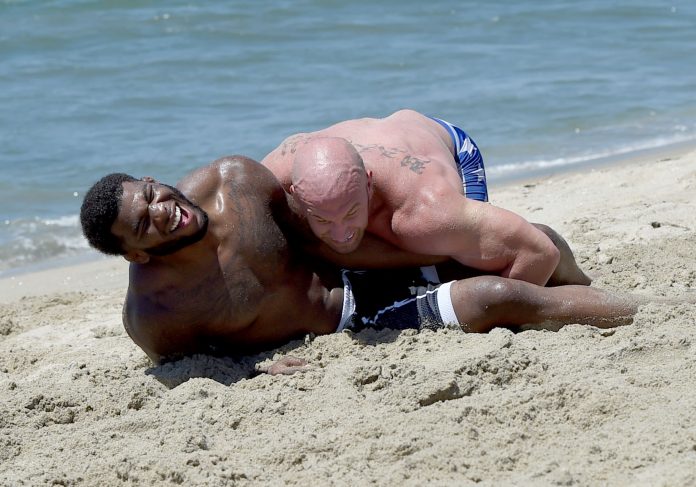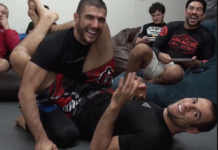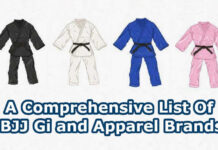
How does your BJJ academy look like? If I had to guess, I’d say it is in a facility that has heating, all the things we take for granted like toilets, changing rooms, maybe a common area or a front desk, and even a small shop. The gym itself is just mats and perhaps a small area for people to watch. the main difference between BJJ gyms is usually the mat space for training, which is dependant on the number of members and the size of the academy. But what happens when you do not have access to any kind of facility for BJJ and grappling training? Would you still train, and how?
In Jiu-Jitsu, we’re used to rolling around on the ground and feeling very comfortable about it. Even though we don’t think about it too often (well, at least not if you’re not an academy owner), the mats are actually a huge part of grappling training. What would happen if you did not have access to mats, though, and you still wanted to train BVJJ. Would you train on a hard surface like wood, or opt to try nature’s mats like snow, grass, or sand?
What If Grappling Training In A Gym Is Not An Option?
Around the world, people don’t always have access to fancy gyms. To be honest, not many academies around the world can look like the very best ones out there. The Mendes academy, Atos HQ, Renzo’s, Marcelo’s, etc are the cream of the crop. For everyone else, a bit of mat space and enough facilities to make people comfortable is more than enough to successfully run a BJJ academy.
However, as widespread as BJJ and grappling is around the world, there are still spots that do not have the facilities necessary for training Sure, you could transform just about any closed space into a gym, but that requires time and money. Weather permitting, training outside is an option in quite a lot of areas of the world, though. And, since mats are not always an option, or sometimes might even end up being a worse one than training on a hard surface, grappling training without them is the only option left.
the question is, would you suck it up and train if you were in such a situation? there are plenty of people around the world that make do with whatever they have at their disposal, and sometimes, even the weather is not on their side. training outside in the snow is a great example of training just because you love to grapple. Training on grass and sand is also not uncommon, as well as las using carpets or wood floors in the absence of mats. And yes, there is a way to train, as long as you’re smart about what you are doing.
Grappling Training Around The World
So, how does grappling training look around the world? Different places offer different grappling martial arts options, sometimes so ingrained in a tradition that using mats for training or competition would be considered disrespectful. In other spots, it is simply what is available to folks for training. Exploring different options of training without BJJ mats, we’ll take a look at several of the options out there, and consider what you should and shouldn’t do when training in such a fashion.
Grass
This might come as a given since so many grapplers have messed around on grass surfaces. The experience is bearable, but far from the comfort of mats, of course. It all depends on how hard the ground is under that grass, and the stuff you’re trying to pull off. Of, course, stuff like Turkish oil wrestling and similar traditional grappling training and competition events demonstrate that training on grass is perfectly possible.
Something to look out for when grappling on grass is, well, nature. Acorns, thorns, rocks, and similar stuff will make your grappling experience very painful if you don’t take al ook around before you engage in a roll or match. Moreover, objects discarded by people, especially broken glass and sharp objects ara always a treat as well.
While this may come as glaringly obvious, rolling around on the grass should be done from the bottom. Takedowns are not going to be fun, especially Judo type of throws. Sticking to starting from the knees is just what the doctor ordered in this situation.
Sand
Beach experiences have probably taught you that you can get away with a lot on sand, but there’s a price to pay. it gets everywhere. Now imagine having to grappler on sand. I’ll just leave it at that.
Around the world, the rea re plenty of spots that have traditional grappling events taking place in sandpits or sand covered rings. Grappling training and even competing on sand makes sense, as it is a surface that can absorb a lot, meaning you could even do takedowns on it. the downside is that it is grainy, and it can cause injuries to the skin, especially in the sensitive areas.
Apart from the odd rock or two, or, depending on where you are, a crab, turtle, or some other animal, there’s not much to worry about when it comes to sand. As long as it is not damp, and there’s plenty of it, you can actually have a great time grappling on it.
The stuff you should stay away from is the complicated inverted type of things that you might usually do on mats. Try to keep your face off the ground as much as possible as the grains will let everywhere and will cause abrasions. Shrimping type of motions with your back against the sand will also come at a price.
Snow
I bet you have not considered grappling training in the snow as an option. Messing around with a teammate from time to time, sure, but not full-on training. Well, not only training but competition in the snow is a thing in certain areas of the world. It is more than obvious that you need some warm clothes for this.
Snow can be tricky to grapple on, though. It may come off as an extremely hard surface, particularly if parts of it are frozen. On the other hand, if it is deeper, the movement might be restricted, especially when ending up on the ground. Plus, whether or not it is still raining snow is also something to factor in.
BJJ and grappling training in the snow is the opposite of training on grass. You can do takedowns and throw,s but you better try and spend as little time on the ground as possible, especially in bottom positions. plus, there’s the fact that snow will get inside your clothes as well.
Carpets
Training on carpets in the absence of mats might look like a good idea. it is not. I am saying this from personal experience. Messing around from time to time on a carpet might be something you can get away with, but doing grappling training regularly on one is going to leave you battered.
Apart from the obvious carpet burn, you’ll need to watch out for material. Some carpets are made of stuff that can cause people to develop a rash or even a full-on allergic reaction. Plus, they’re very uncomfortable for both takedown training and rolling around on the ground. They could, though, perhaps pass as surfaces for doing some partner drills, or perhaps, slow-rolling / position sparring.
Wooden floors
Something that is not unheard of, archaically in the east. In Japan, for example, they have special wooden floors made out of bamboo (I think) that were used for Japenese Ju-Jitsu training in ancient times. That said, as uncomfortable as it may sound, grappling training on a hardwood floor can actually be quite a good option.
As long as the wood is smooth, you could pull off certain aspects of BJJ and grappling training. Of course, rustic style wood floors made ou of 2x4s are definitely not an option. That said, different types of wooden floors have different absorption characteristics and even different densities.
That brings us to what you can do. Any standing training goes out the window here, and you should be very careful with everything else, too. You can’t just throw yourself around here, because hitting the floor with the side of the hip won’t be nearly as pleasant as with any o the options above, or mats. Sow rolling is the only way to go here, with lots of looking out for both yourself and your training partners.
Not All Mats Are Made Equal
Before we move on to wrap things up, let’ take a look at how different types of mats might feel. Yo usee, when ti comes to Jiu-Jitsu mats, they are not just different in type or color. They differ in core material and texture as well.
When it comes to the core of grappling mats it usually comes to one of three options. Those are polyvinyl chloride (PVC) nitrile foam, cross-linked polyethylene (PE) foam, or ethylene-vinyl acetate (EVA) foam. The core material also impacts the thickness of the mats which is crucial for grappling training. try training on mats designed for karate, and you’ll see what I mean. A minimum thickness of at least an inch is an absolute must for training Jiu-Jitsu.
In terms of texture, you want mats to offer a grip, but not be too grainy to make it feel like you’re rolling on the sand. That is a fine balance that some BJJ mat manufacturers know how to achieve. EVA mats with a tatami texture are the best bet. It will provide a grip, while not causing mat burns nor becoming slippery when wet, as some canvases do.
Final Words
Nothing can stop you from training Jiu-Jitsu if you’re dead set on it. Grappling training is possible on a wide array of surfaces, but only if you are able to accept the fact that it will never feel the same as BJJ mats do. There will be limitations, but you can pull it off, and even get good results with it. As you can see from the examples above, there’s even an option to organize tournaments under such circumstances as well.










































